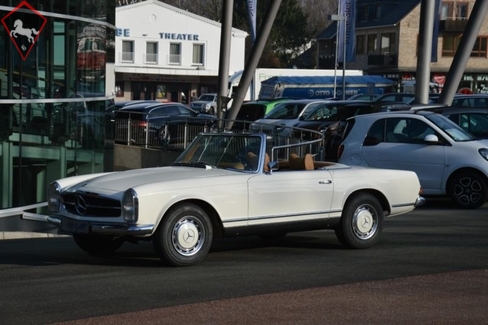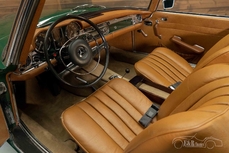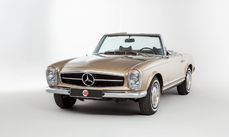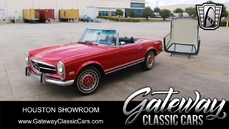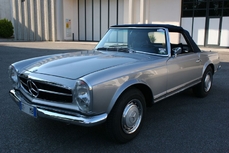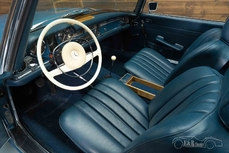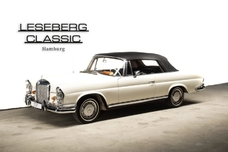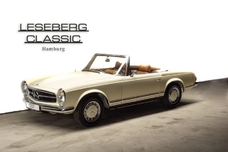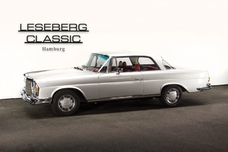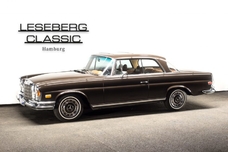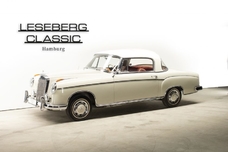Mercedes-Benz 280SL w113 SL Leder 1970
General description :
Interne Fahrzeugnr.: OLD3076
Standort: Leseberg Automobile GmbH in Hamburg (PLZ 22549), Dieser 280 SL ist ursprünglich in Deutschland ausgeliefert worden. Der letzte Verkauf fand am 6.6.1980 in Norderstedt bei der Firma Behrmann statt. Der Kaufvertrag und die Rechnung über DM 25.000,- (entspricht etwa EUR 12.500,-) sind im Original erhalten. Nun möchte sich der Eigentümer aus Altersgründen (er ist Jahrgang 1932) nach 38 (!!) Jahren von dem Wagen trennen. In seinem Auftrag bieten wir den SL an.
Das Werk verlassen hat der 113er in mittelblau (903) im April 1970. In dem Kaufvertrag wird bereits ein Tauschmotor erwähnt.
Aus der Zeit von 1993 bis 1995 existieren Rechnungen, die eine umfangreiche Restaurierung belegen. Die damals zu zahlende Summe übersteigt leicht DM 111.000,- (entspricht rund EUR 55.500,-) und damit den Zeitwert von 1995 bei Weitem.
Spätere Rechnungen zeigen, dass diese Pagode stets gepflegt wurde - und zwar von sehr guten Adressen in Hamburg.
Als sich die Notwendigkeit des Verkaufs dieses Mercedes abzeichnete, wurde der SL noch umfangreich überarbeitet. Der nach über zwanzig Jahren leicht in Mitleidenschaft gezogene Lack wurde daher erneuert, die Innenausstattung ist nun in Leder gehalten (ab Fabrik hatte MB-Tex Verwendung gefunden), der Teppich und auch das Verdeck (dunkelbraun) sind neu, das Holz wurde überarbeitet. Sogar die Sonnenblenden sind bedacht worden - sie sind montiert, aber noch in Folie verpackt !
Bei unserer Abholung des Autos in der ausführenden Werkstatt der letzten Arbeiten hat der Eigentümer seinen SL das erste mal überhaupt nach Abschluß eben dieser Aufarbeitung gesehen und noch ein paar Abschiedsbilder geschossen.
Ausgestattet ist die Pagode mit einer Servolenkung, getönten Scheiben, Kopfstützen, einem originalen Becker Radio und modernen Automatik-Gurten.
Der angegebene Kilometerstand ist lediglich abgelesen. Die tatsächliche Laufleistung ist nicht bekannt.
Der 280 SL sieht nicht nur sehr gut aus, er fährt auch ganz ausgezeichnet. Abgesehen von einem neuen Eigentümer braucht dieser SL derzeit gar nichts ...
Sonstiges:
Keine Haftung für Druck & Schreibfehler
Irrtum und Zwischenverkauf vorbehaltenpowered by two S
https://home.mobile.de/LESEBERGCLASSICCENTER#des_258082375
1970 Mercedes-Benz 280SL w113 SL Leder is listed sold on ClassicDigest in Hamburg by Auto Dealer for €127500.
Car Facts
Car type : Car Make : Mercedes-Benz Model : 280SL w113 Model Version : SL Leder Engine size : 2.8 Model Year : 1970 Sub type : Convertible Location : Osdorfer Landstrasse 193-217DE-22549 Hamburg
Sold
Seller Information
Sold
People who viewed this Mercedes-Benz 280SL w113 also viewed similar Mercedes-Benz listed at ClassicDigest
Other cars listed for sale by this dealer
About Mercedes-Benz
In the annals of automotive history, the journey of Mercedes-Benz is a tale that unfolds with the ingenuity of its founding pioneers. In the year 1886, Karl Benz crafted the Benz Patent Motorwagen, a creation that would go down in history as the world's inaugural automobile. Unbeknownst to him, this moment marked the genesis of what would evolve into the most illustrious premium car manufacturer globally. The financial underpinning of this pioneering venture, interestingly, was provided by Karl Benz's wife, Bertha Benz, demonstrating a remarkable partnership that would set the tone for Mercedes-Benz's legacy.A parallel narrative emerged not far away, as Daimler-Motoren-Gesellschaft, founded by Gottlieb Daimler and Wilhelm Maybach, entered the scene. In 1901, they unveiled their automobile under the now-famous moniker "Mercedes," meaning "godsend" in Spanish. This name was bestowed upon the car at the behest of Emil Jellinek's daughter, the distributor for Daimler-Motoren-Gesellschaft. The wheels of innovation were set in motion.
Fast forward to 1926, a pivotal year that witnessed the merger of Daimler with Benz & Cie., culminating in the birth of Daimler-Benz. The amalgamation saw the adoption of "Mercedes-Benz" as the distinguished trademark for their automobiles, fusing the legacies of two visionary entities into one.
Contrary to perceptions of conservatism, the trajectory of Daimler-Benz unfolds as a chronicle of industry firsts. From the introduction of the honeycomb radiator to the float carburetor, and the pioneering implementation of four-wheel brakes in 1924, Daimler-Benz consistently pushed the boundaries of automotive innovation. The diesel-powered Mercedes-Benz 260 D in 1936 marked the inception of diesel engines in passenger cars. The iconic Mercedes-Benz 300SL Gullwing made history as the first car with direct fuel injection, albeit the Gutbrod's tiny 2-stroke engine can claim precedence.
Safety innovations became a hallmark, with Béla Barényi's patented safety cell design in the "Ponton"-models in 1951, featuring front and rear crumple zones. The W116 450SEL 6.9 saw the introduction of the Anti-Lock Brake system (ABS), another pioneering safety feature. From the first production airbags and beyond, the legacy of "firsts" continued to be etched into the fabric of Daimler-Benz.
Over its centennial journey, Mercedes-Benz has not merely produced cars but has sculpted automotive icons. The SSKL, 710 SSK Trossi Roadster, 770K Grosser, 540K Spezial Roadster, 300SL Gullwing, w100 600 Pullman, w111 280SE 3.5 Flachkühler, w113 230SL Pagoda, w109 300 SEL 6.3, and w201 2.3-16 Cosworth stand testament to the brand's commitment to engineering excellence.
The roaring Silver Arrows, or "Silberpfeile," including the W 25, W 125, W154, W165, and W196, created a legacy of dominance on the racetrack. These machines were not merely cars; they were expressions of precision, speed, and an indomitable spirit that left their competitors in the dust.
As Mercedes-Benz marches into the future, it does so not just as an automaker but as a custodian of a legacy, a torchbearer of innovation, and a beacon of automotive excellence. The road ahead is sure to witness the continued fusion of cutting-edge technology, timeless design, and an unwavering commitment to setting new standards in the world of automobiles.
One luminary figure who left an indelible mark was Béla Barényi, often heralded as the "father of passive safety" for his pioneering work in safety engineering. His patented safety cell design, featuring front and rear crumple zones, became a hallmark of Mercedes-Benz's commitment to occupant safety, setting new standards that reverberated throughout the automotive world.
Moving through the chronicles, the collaborative genius of Wilhelm Maybach, alongside Gottlieb Daimler, laid the foundation for Daimler-Motoren-Gesellschaft. Their innovations not only birthed the first Mercedes but established a culture of relentless pursuit of technological excellence that remains integral to Mercedes-Benz's DNA.
In the post-merger era of 1926, Ferdinand Porsche emerged as a prominent figure within Mercedes-Benz. His work on the Mercedes-Benz S-Type, a supercharged race car, garnered acclaim and set the stage for a legacy that extended far beyond the marque. Porsche's impact would later extend to his eponymous company, but his influence at Mercedes-Benz during those formative years was pivotal.
As the 20th century progressed, the legendary Rudolf Uhlenhaut emerged as a key figure. Uhlenhaut, an accomplished engineer and the driving force behind the iconic Silver Arrows, played a crucial role in Mercedes-Benz's dominance in motorsports. His engineering prowess and attention to detail were instrumental in creating some of the most formidable racing cars of the era.
In the latter half of the century, figures like Bruno Sacco, the head of design at Mercedes-Benz from 1975 to 1999, left an indelible imprint on the brand's aesthetic identity. Sacco's design philosophy, characterized by clean lines and timeless elegance, shaped iconic models like the W126 S-Class and the W201 190E, solidifying Mercedes-Benz's reputation for luxury and sophistication.
The narrative would be incomplete without acknowledging the contributions of engineers like Hans Scherenberg, whose leadership in the 1970s ushered in a new era of technological innovation at Mercedes-Benz. Scherenberg's tenure saw the development of groundbreaking technologies, including the Anti-Lock Brake system (ABS) and the introduction of airbags in production cars.
